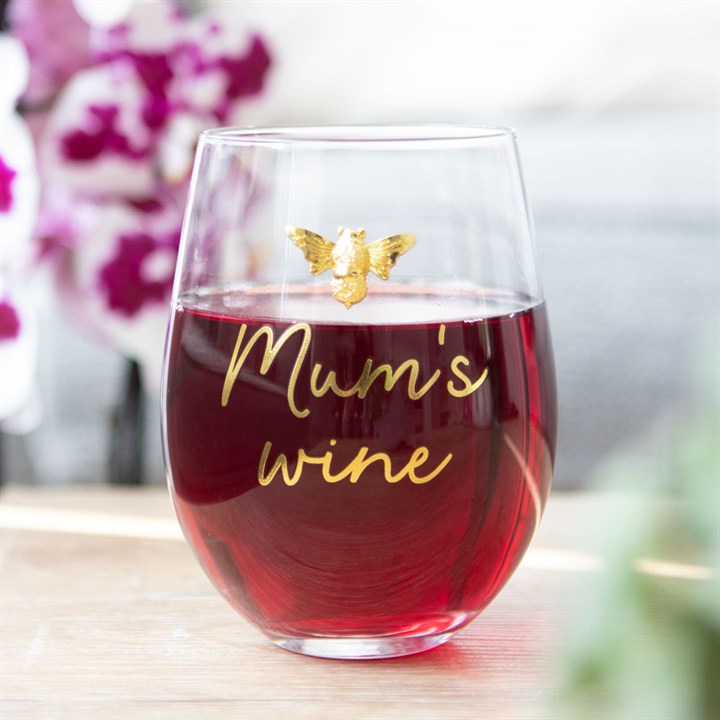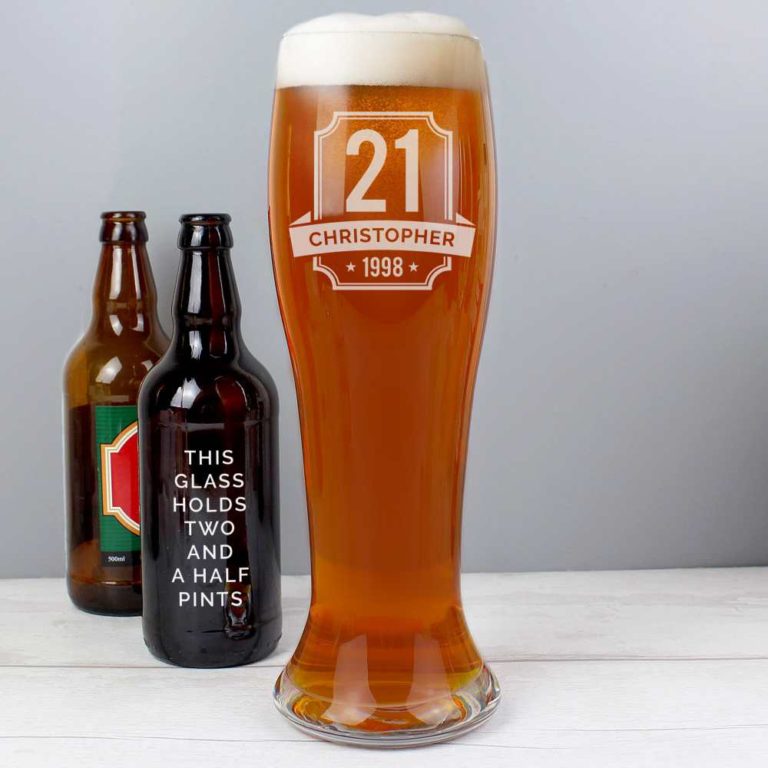FREE Tracked Delivery on all Items to UK Mainland
We Love personalised gift shops and Personalised gifts for friends and family.....so we made our own.
Shop with Confidence
Glasses and Barware
Discover the perfect gift with our range of personalised glasses, no matter the occasion, from weddings and anniversaries to special birthdays or retirements. Whether it’s a tumbler, champagne flute, shot glass, wine glass, pint or hi-ball glass, we’ve got it covered, so come and find a glass with their name on it today!
Glass and Barware History
Wine glasses and other types of drinking glasses have a long history in the UK, with their use developing significantly from the medieval period onward.
Medieval Period (5th to 15th centuries): In early medieval Britain, most people used cups or goblets made from wood, pottery, or metal for drinking. Glassware was rare and expensive, typically reserved for the wealthy or for ceremonial purposes. Some glass vessels were imported from Europe, especially Venice, which was a major centre of glass production.
16th to 17th centuries: By the Renaissance, glassmaking had improved in the UK, particularly after Italian glassmakers, known for their high-quality work, migrated to England. Drinking glasses, including wine glasses, became more common among the upper classes. During this period, glass vessels such as goblets, beakers, and flutes began to be produced in Britain, often inspired by Venetian designs.
Late 17th century: The invention of lead glass (or crystal) by George Ravenscroft in 1674 revolutionised British glassmaking. Lead glass was clearer and easier to shape, making it ideal for delicate and decorative items like wine glasses. This marked the beginning of Britain’s strong reputation for producing fine drinking glassware, and wine glasses became increasingly popular at this time.
18th to 19th centuries: The use of specific glassware for different types of drinks (wine glasses, beer glasses, etc.) became more established. The design of wine glasses evolved, with the introduction of stemware, which allowed drinkers to hold the glass without warming the wine with their hands. By the 18th century, wine glasses had distinct shapes, with larger bowls for red wine and smaller bowls for white wine.
20th century to today: Glassware became mass-produced and affordable, and the variety of shapes and styles expanded further. Today, the UK, like much of the world, uses a wide range of glasses for different drinks, from wine and beer glasses to tumblers and flutes, with specific designs tailored to enhance the drinking experience.
So, the use of wine glasses and other specific types of drinking glasses in the UK became widespread from the 17th century onward, with earlier forms of glass vessels dating back to the medieval period.
Is It Good To Gift Glass Items?
Yes, gifting glass items can be a great choice, especially when they are personalised or thoughtfully chosen. Here are a few reasons why glass gifts can be excellent:
Elegance and Versatility
Glass items, such as wine glasses, vases, or decorative pieces, often have a timeless elegance that makes them suitable for a variety of occasions, from weddings and anniversaries to birthdays and retirements.
Personalisation
Personalising glassware, like engraving a name, date, or special message, adds a thoughtful and unique touch. Personalised glass gifts feel more meaningful and memorable, making them great for special milestones or celebrations.
Durability (when treated well)
High-quality glass items, like crystal glasses or decorative ornaments, can last a long time when cared for properly. They become keepsakes that people can treasure for years.
Suitable for Various Occasions
Glass gifts can be tailored to different events—such as wine glasses for anniversaries, champagne flutes for weddings, or a unique glass vase for a housewarming gift.
Aesthetic Appeal
Glass gifts, especially those with intricate designs or artistic elements, can be visually stunning. They make beautiful additions to home décor, combining both functionality and beauty.
Wide Range of Options
Whether it’s drinkware (like personalised tumblers or champagne flutes), decorative glass ornaments, or practical items like glass coasters or picture frames, there’s a wide range of options to suit different tastes and budgets.
Considerations
Fragility: While glass gifts are lovely, their fragile nature means they might not be ideal for everyone or every situation, especially if there’s a risk of breakage.
Packaging: Make sure to wrap and package glass items securely to avoid damage during transportation or handling.
In short, glass items, especially when personalised, can make thoughtful, elegant, and memorable gifts for a variety of occasions.
Is Glass An Anniversary Gift?
Yes, glass is traditionally associated with the 3rd wedding anniversary. Here in the UK and in some other countries, certain anniversaries are linked to specific materials, each symbolising different qualities that strengthen over time. For the third anniversary, glass represents the clarity and transparency that should be present in a marriage by that time, reflecting how the couple understands and sees each other more clearly.
Gifting glass for a 3rd anniversary can be a meaningful and elegant choice. Popular glass gift ideas include:
- Personalised glassware (e.g., wine glasses, tumblers, or champagne flutes)
- Decorative glass ornaments
- Glass photo frames
- Crystal vases or candle holders
These gifts can symbolise the beauty and strength of the relationship, even though glass is delicate, it’s also cherished and valuable when cared for—much like a marriage.
What Is The Meaning of a Glass Gift?
A glass gift often carries symbolic meanings related to clarity, transparency, and fragility. These qualities make it a thoughtful and meaningful gift choice for various occasions. Below is a breakdown of the symbolic meanings associated with giving glass as a gift:
Clarity and Transparency
Symbol of Honesty: Glass is clear and transparent, symbolising openness and honesty in relationships. When given as a gift, it can represent the desire for a relationship to be based on trust and clear communication.
Reflection of Understanding: The clarity of glass can also symbolise seeing things clearly and deeply, reflecting mutual understanding in friendships, marriages, or partnerships.
Fragility and Care
Delicacy of Relationships: Glass is strong yet fragile, symbolising how relationships, while valuable, need to be handled with care. This can be a thoughtful reminder of the care and effort needed to maintain a bond.
Symbol of Protection: The fragility of glass can also represent a protective feeling, encouraging both parties to guard and nurture their relationship.
Elegance and Beauty
Aesthetic and Artistic Value: Glass gifts, particularly those that are well-crafted or personalised, symbolise beauty, sophistication, and a sense of timeless elegance. This reflects the appreciation and value the giver has for the recipient.
Transformation
Symbol of Growth: Glass, made from sand that has been transformed through fire, can symbolise personal growth, transformation, or a relationship that has endured challenges and emerged stronger.
Purity and Light
Connection to Purity: The purity of glass, especially when it is crystal-clear, symbolises innocence and pure intentions. Giving a glass gift can be seen as offering a sincere and heartfelt gesture.
Light and Reflection: Glass reflects and refracts light, symbolising hope, positivity, and the spreading of good energy.
In conclusion, a glass gift can hold deep meanings, depending on the context. It often symbolises clarity, care, transformation, and elegance—qualities that make it a thoughtful choice for personal or meaningful occasions such as anniversaries, weddings, or significant life events.
Is It Good To Gift Glass Items?
Glass etiquette refers to the proper way to handle and use glassware, particularly in social or formal settings, such as during meals, parties, or celebrations. This is especially important when using items like wine glasses, champagne flutes, or other delicate glassware. Below are some key guidelines for glass etiquette:
Holding the Glass Properly
Wine Glasses: Hold the wine glass by the stem rather than the bowl. This prevents the warmth of your hand from affecting the temperature of the wine, which is important for the tasting experience. It also avoids smudging the glass, keeping it clear and clean.
Champagne Flutes: Similarly, hold champagne flutes by the stem to maintain the cool temperature of the drink.
Tumbler or Highball Glasses: These can be held around the body of the glass, as the drinks they typically contain (like whisky or cocktails) are often served with ice or at room temperature.
Serving Etiquette
Wine: When pouring wine, pour up to one-third full in the glass to allow room for swirling and releasing the wine’s aromas. For red wine, slightly more can be poured; for white wine, pour a little less to maintain its chilled temperature.
Champagne or Sparkling Wine: Fill champagne flutes about two-thirds full to allow space for the bubbles to rise.
Water: Water glasses should be filled close to the top but leave a small gap to prevent spilling when picked up.
Using the Right Glass for the Right Drink
Different drinks are served in specific types of glasses. Here are the common pairings:
Red Wine: Large, round-bowled glasses to enhance the wine’s exposure to air, which helps release its flavours.
White Wine: Smaller, narrower glasses to keep the wine cooler for longer.
Champagne or Sparkling Wine: Tall, slender flutes to maintain the bubbles and preserve the sparkling effect.
Beer: Beer glasses or pints, depending on the type of beer.
Cocktails: Different types of cocktails may be served in specific glasses like martini glasses, highball glasses, or tumblers.
Clinking Glasses
Toasting: When toasting, gently tap the rim of your glass against others rather than clinking too hard. This avoids damaging or breaking the glass, especially with delicate stemware like wine or champagne glasses.
Eye Contact: It’s considered polite to maintain eye contact when making a toast and clinking glasses.
Resting the Glass
Between sips, place the glass on the table in front of you. Don’t cradle or continuously hold the glass unless you’re actively drinking, as it can warm the drink.
Avoid placing a wet glass directly on a wooden surface to prevent water rings, use a coaster if available.
Polishing the Glass
If you’re hosting, make sure your glassware is clean and polished, free of smudges or water spots. This enhances the appearance and enjoyment of the drink.
When to Use Glassware
Use glassware appropriate for the drink and the occasion. For example:
Casual events: Tumblers and highball glasses are fine for everyday use.
Formal dinners or celebrations: Use more elegant glassware like wine glasses, champagne flutes, and crystal glasses to elevate the event.
Handling Broken Glass
If a glass breaks or chips, discard it immediately and carefully clean up the area to prevent accidents. Do not use damaged glassware, as it can be dangerous.
Avoid Overfilling
Overfilling glasses, particularly with wine or champagne, can lead to spills when guests try to sip or pick up their glass. It’s better to refill more often than to risk a mess.
By following these guidelines, you can handle glassware gracefully and appropriately, enhancing the experience for yourself and others during meals or social gatherings.







